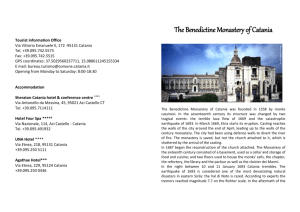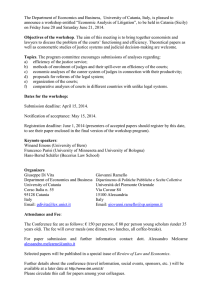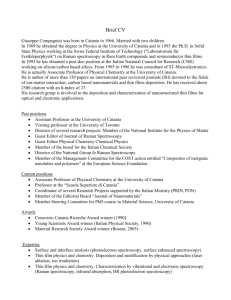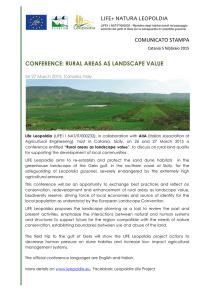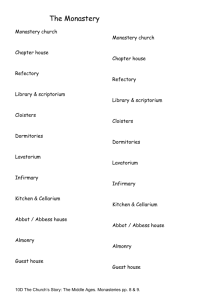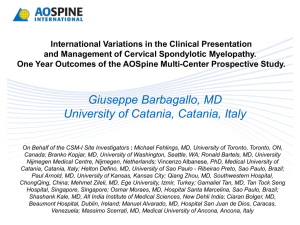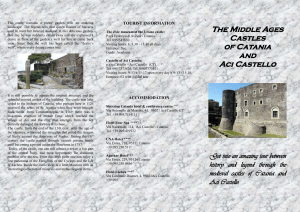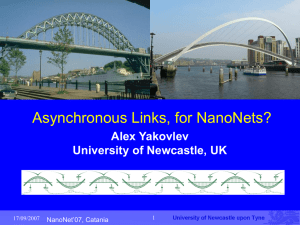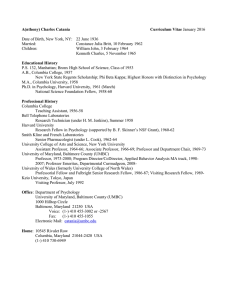The Benedictine Monastery of Catania was founded in 1558 by
advertisement
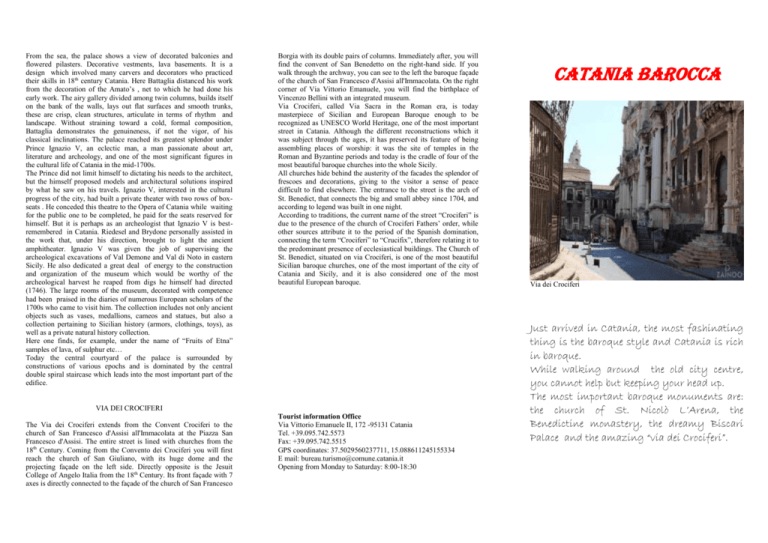
From the sea, the palace shows a view of decorated balconies and flowered pilasters. Decorative vestments, lava basements. It is a design which involved many carvers and decorators who practiced their skills in 18th century Catania. Here Battaglia distanced his work from the decoration of the Amato’s , net to which he had done his early work. The airy gallery divided among twin columns, builds itself on the bank of the walls, lays out flat surfaces and smooth trunks, these are crisp, clean structures, articulate in terms of rhythm and landscape. Without straining toward a cold, formal composition, Battaglia demonstrates the genuineness, if not the vigor, of his classical inclinations. The palace reached its greatest splendor under Prince Ignazio V, an eclectic man, a man passionate about art, literature and archeology, and one of the most significant figures in the cultural life of Catania in the mid-1700s. The Prince did not limit himself to dictating his needs to the architect, but the himself proposed models and architectural solutions inspired by what he saw on his travels. Ignazio V, interested in the cultural progress of the city, had built a private theater with two rows of boxseats . He conceded this theatre to the Opera of Catania while waiting for the public one to be completed, he paid for the seats reserved for himself. But it is perhaps as an archeologist that Ignazio V is bestremembered in Catania. Riedesel and Brydone personally assisted in the work that, under his direction, brought to light the ancient amphitheater. Ignazio V was given the job of supervising the archeological excavations of Val Demone and Val di Noto in eastern Sicily. He also dedicated a great deal of energy to the construction and organization of the museum which would be worthy of the archeological harvest he reaped from digs he himself had directed (1746). The large rooms of the museum, decorated with competence had been praised in the diaries of numerous European scholars of the 1700s who came to visit him. The collection includes not only ancient objects such as vases, medallions, cameos and statues, but also a collection pertaining to Sicilian history (armors, clothings, toys), as well as a private natural history collection. Here one finds, for example, under the name of “Fruits of Etna” samples of lava, of sulphur etc… Today the central courtyard of the palace is surrounded by constructions of various epochs and is dominated by the central double spiral staircase which leads into the most important part of the edifice. Borgia with its double pairs of columns. Immediately after, you will find the convent of San Benedetto on the right-hand side. If you walk through the archway, you can see to the left the baroque façade of the church of San Francesco d'Assisi all'Immacolata. On the right corner of Via Vittorio Emanuele, you will find the birthplace of Vincenzo Bellini with an integrated museum. Via Crociferi, called Via Sacra in the Roman era, is today masterpiece of Sicilian and European Baroque enough to be recognized as UNESCO World Heritage, one of the most important street in Catania. Although the different reconstructions which it was subject through the ages, it has preserved its feature of being assembling places of worship: it was the site of temples in the Roman and Byzantine periods and today is the cradle of four of the most beautiful baroque churches into the whole Sicily. All churches hide behind the austerity of the facades the splendor of frescoes and decorations, giving to the visitor a sense of peace difficult to find elsewhere. The entrance to the street is the arch of St. Benedict, that connects the big and small abbey since 1704, and according to legend was built in one night. According to traditions, the current name of the street “Crociferi” is due to the presence of the church of Crociferi Fathers’ order, while other sources attribute it to the period of the Spanish domination, connecting the term “Crociferi” to “Crucifix”, therefore relating it to the predominant presence of ecclesiastical buildings. The Church of St. Benedict, situated on via Crociferi, is one of the most beautiful Sicilian baroque churches, one of the most important of the city of Catania and Sicily, and it is also considered one of the most beautiful European baroque. VIA DEI CROCIFERI The Via dei Crociferi extends from the Convent Crociferi to the church of San Francesco d'Assisi all'Immacolata at the Piazza San Francesco d'Assisi. The entire street is lined with churches from the 18th Century. Coming from the Convento dei Crociferi you will first reach the church of San Giuliano, with its huge dome and the projecting façade on the left side. Directly opposite is the Jesuit College of Angelo Italia from the 18th Century. Its front façade with 7 axes is directly connected to the façade of the church of San Francesco Tourist information Office Via Vittorio Emanuele II, 172 -95131 Catania Tel. +39.095.742.5573 Fax: +39.095.742.5515 GPS coordinates: 37.5029560237711, 15.088611245155334 E mail: bureau.turismo@comune.catania.it Opening from Monday to Saturday: 8:00-18:30 CATANIA BAROCCA Via dei Crociferi Just arrived in Catania, the most fashinating thing is the baroque style and Catania is rich in baroque. While walking around the old city centre, you cannot help but keeping your head up. The most important baroque monuments are: the church of St. Nicolò L’Arena, the Benedictine monastery, the dreamy Biscari Palace and the amazing “via dei Crociferi”. THE BENEDICTINE MONASTERY The Benedictine Monastery of Catania was founded in 1558 by monks cassinesi.In the seventeenth century its structure was changed by two tragical events: the terrible lava flow of 1669 and the catastrophic earthquake of 1693. In March 1669, Etna starts its eruption. Casting reaches the walls of the city around the end of April, leading up to the walls of the century monastery. The city had been using defence walls to divert the river of fire. The monastery is saved, but not the church attached to it, which is shattered by the arrival of the casting. In 1687 began the reconstruction of the church attached. The Monastery of the sixteenth century consisted of a basement, used as a cellar and storage of food and cuisine; and two floors used to house the monks' cells, the chapter, the refectory, the library and the parlour as well as the cloister dei Marmi. In the night between 10 and 11 January 1693 Catania trembles. The earthquake of 1693 is considered one of the most devastating natural disasters in eastern Sicily: the Val di Noto is razed. According to experts the tremors reached magnitude 7.7 on the Richter scale. In the aftermath of the earthquake the city is destroyed and most of the people of Catania is buried under the rubble .Monastery of the sixteenth century remains intact basement and the first floor. The cloister remain erected 14 columns other fall down and break. Since 1702 began the reconstruction and the Monastery is repopulated by monks from other monasteries. Larger than the plant primeval: the Cloister dei Marmi is added to the Cloister of Levante, with the garden and the Caffeaos in eclectic style, and the north with the spaces to day life and collective life of the monks: the library, the kitchens, the 'wing of the novitiate, the refectory, the chorus of night. It exploits the lava bench to achieve the two roof gardens, the Botanical Gardens and the garden of the Novices. The church of St. Nicholas Arena, adjacent to the new monastic complex remains unfinished in the main façade. Larger, decorated, altered, the monastery became one of the largest monasteries in Europe, second, between those of the Benedictine order, only to that of Mafra in Portugal. Starting from 1868 most of the spaces were rearranged for “civil” uses. These were mainly schools, including the most famous was the Regio Istituto Carlo Gemmellaro, but is also allocated to the Military Barracks and the Astrophysical Observatory with the laboratory of Meteorology and Geodynamics. The new uses caused a series of profound changes that the Monastery suffered despite its recognition, the Unification of Italy, as a National Monument erased most of the frescoes, divided the hallways, roofs, loft, introduced accretions to make room for offices, gyms, latrines. The Botanical Garden of almost 5 acres is divided up to house the pavilions of the new hospital dedicated to the king of Italy, Vittorio Emanuele. The Church of St. Nicholas who lives his last moment of glory with the Rector Della Marra, appointed personally by Cardinal Dusmet, becomes good of worship then in use of the City of Catania. The sacristy, also built by Vaccarini, welcomes Shrine dedicated to the fallen of the two wars. Only the beautiful monastic library is spared. The book collection of the monks, which includes gorgeous herbaria, sixteenth and illuminated bibles, plus the collections of other orders abolished and private. “The Public United Libraries Ursino Recupero” today are made up of three main areas: the reading room built inside the museum of the Benedictines, the circular conference room, and the sumptuous Sala Vaccarini. In 1977 as part of the redevelopment of the historic center of the city, the city of Catania gives the Benedictine Monastery at the University of Catania, which destines him to the seat of the historical Faculty of Humanities. Since 2002 it becomes a World Heritage Site that UNESCO identifies as a representative of the late baroque of southeastern Sicily. churches in Europe. Famous for its Meridian and for its organ with 2378 pipes. It is now used for concerts and local events. BISCARI PALACE Palazzo Biscari the most magnificent private building in Catania, is unique in terms of structure, outlay and decoration. It is composed of seven hundred rooms, it is located in the old quarter of Catania behind the popular town area, overlooking the port on the famous marina arches, where train still passes. Up until the 1920s the ocean water reached the precipitous bastions. Eventually, the water’s edge retired and after a second intervention the water moved far away from the palace, which became the elegant and the desired sentinel of Catania. The heart of the palace is formed by its halls restored after the 1991 earthquake. The paintings and frescoes are also restored to their original condition. To the right of the courtyard, instead, there are other private apartments where eleven members of the family reside. THE CHURCH OF St. NICOLA L’ARENA The original construction much smaller than the present monastery, changed a lot because of two major natural disasters. The first is the eruption of 1669 when the “lava” hit the north-west side of the monastery and destroyed the church. After the earthquake of 1693, it was slowly rebuilt by Stefano Ittar and Francesco Battaglia. Still today it is one of the largest catholic After the earthquake of 1693 destroyed nearly the entire city, Prince Ignazio Paternò Castello, obtained permission from the deputy general Giuseppe Lanza, duke of Camastra, to build the new palace on the ramparts of the 15th century walls. The best architects in Catania at that time, Alonzo Di Benedetto, Girolamo Palazzotto, Francesco Battaglia and his son Antonino, participated in the construction, which lasted more than a century. At the beginning of the 1700s the building had the shape of a trapezoid, centered upon a large courtyard to which access was gained by a richly decorated doorway on top of which stood the four-quartered arms of nobility. During the first decade of the century Antonino Amato finished the decoration of the seaside façade.
